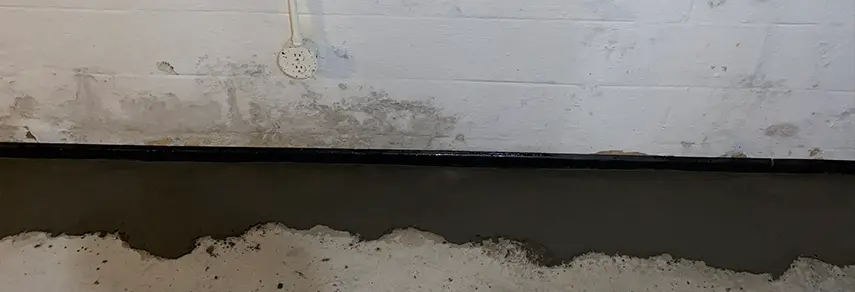Tired of dealing with damp concrete floors? Discover proven solutions to stop moisture coming through concrete floor, protecting your home and investment.
Understanding Concrete Floor Moisture Problems
Moisture rising through concrete floors is a common issue that affects many UK properties, particularly those built before modern damp-proofing methods became standard. The problem occurs when groundwater moves upward through the concrete’s porous structure via capillary action. This natural process, known as rising damp, can lead to significant issues if left untreated. Recent studies show that over 60% of UK homes with concrete floors experience some form of moisture-related problems. Common signs include dark patches on the floor, musty odours, peeling floor coverings, and efflorescence (white, powdery deposits on the surface). Understanding these symptoms is crucial for implementing effective solutions.
Testing for Moisture in Concrete Floors
- Calcium Chloride Test: Measures moisture vapor emission rate (MVER) over 24-72 hours
- Relative Humidity Testing: Uses probes inserted into the concrete to measure internal moisture levels
- Electronic Moisture Meters: Provides quick surface readings but less accurate than other methods
- Visual Inspection: Look for dampness, discoloration, or mould growth
- Plastic Sheet Test: Simple DIY method involving taping plastic to the floor for 24 hours to check for condensation
Primary Solutions for Concrete Floor Moisture
1. Vapor Barriers and Moisture Membranes
Installing a vapor barrier is one of the most effective long-term solutions for preventing moisture infiltration. Modern vapor barriers are typically made from high-density polyethylene (HDPE) or similar materials, offering up to 99% protection against moisture transmission. For existing floors, surface-applied membranes like epoxy-based systems can create an effective moisture barrier. These solutions typically cost between £15-30 per square metre for materials and professional installation.
2. Concrete Waterproofing Sealers
- Penetrating Sealers: Silicate-based solutions that penetrate and react with concrete
- Surface Sealers: Create a protective film on the concrete surface
- Crystalline Waterproofing: Forms crystals within concrete pores
- Acrylic Sealers: Provide good moisture protection and enhance appearance
3. Epoxy Coating Systems
Epoxy coatings represent a premium solution for moisture control, offering both protection and aesthetic benefits. Modern epoxy systems can achieve moisture vapor transmission rates below 3 pounds per 1,000 square feet. These systems typically consist of a primer, moisture barrier, and topcoat, creating a seamless, durable surface that’s both waterproof and attractive.
Environmental Moisture Control Methods
1. Proper Drainage Solutions
External drainage plays a crucial role in preventing moisture problems. Studies show that proper drainage can reduce basement moisture by up to 85%. Key elements include maintaining gutters, installing French drains, and ensuring proper ground slope away from the building (minimum 1:50 gradient). Regular maintenance of these systems is essential for long-term effectiveness.
2. Ventilation and Dehumidification
- Install mechanical ventilation systems in high-moisture areas
- Use dehumidifiers to maintain relative humidity below 60%
- Ensure adequate air circulation with fans or air movers
- Consider installing humidity-controlled ventilation systems
- Regular monitoring of indoor humidity levels
Professional Solutions for Severe Cases
1. Moisture Mitigation Systems
For severe moisture issues, professional moisture mitigation systems offer comprehensive protection. These systems typically involve multiple layers of specialized materials and can cost between £25-40 per square metre. The investment is justified by their effectiveness, with success rates exceeding 95% in controlling moisture problems.
2. Cavity Drainage Systems
Cavity drainage systems represent a modern approach to managing severe moisture issues, particularly in basements. These systems create a controlled space for water management, directing moisture to a suitable drainage point. While installation costs can range from £70-100 per square metre, they provide a permanent solution for challenging moisture problems.
Preventive Measures and Maintenance
- Regular inspection of seals and coatings
- Annual testing of moisture levels
- Prompt repair of any cracks or damage
- Maintaining proper indoor humidity levels
- Regular cleaning and maintenance of drainage systems
When to Call a Professional
Professional intervention becomes necessary when you observe persistent moisture issues despite basic interventions. Key indicators include rising damp above 1.5 metres, extensive efflorescence, or failed DIY solutions. Recent surveys indicate that 78% of successful moisture remediation projects involved professional assessment and installation. At Bromley Tilers, we provide expert consultation and implementation of moisture control solutions, ensuring long-lasting results for your concrete floor issues.
Conclusion: Ensuring Long-Term Floor Protection
Controlling moisture in concrete floors requires a comprehensive approach combining appropriate barriers, sealers, and environmental control methods. Success depends on proper assessment, choosing the right solution, and maintaining preventive measures. While some solutions can be implemented as DIY projects, complex cases benefit from professional expertise. With proper treatment and maintenance, you can effectively stop moisture from coming through your concrete floor, protecting your property’s value and ensuring a healthy living environment.
FAQ
How to draw moisture out of a concrete floor?
If moisture seepage is already occurring, the most effective way to remove it is to use a dehumidifier and fans to draw out the humidity from the air. This should be done in conjunction with sealing the slab.
How to apply deep penetrating sealer?
And dry time guidelines. Found on the label or tech data sheet remove any furniture. And cover plants that you wish to protect.
What is the fastest way to get moisture out of concrete?
A dehumidifier near the damp area can help reduce humidity levels and quickly draw out excess moisture. Ensuring good ventilation in your home or business will also help keep moisture levels down and prevent dampness from forming on your concrete floors.
Will sealing a concrete floor reduce moisture?
Our sealers fill capillaries and gaps, permanently blocking the transmission of moisture up through the concrete slab and preventing moisture issues. Bone Dry concrete sealers are an affordable alternative to epoxy sealers and are simple to apply indoors or outdoors using a standard pressurized garden sprayer.
Sources
[1] https://polyguard.com/blog/moisture-through-concrete-slab
[2] https://advantaclean.com/ft-lauderdale-fl/about-us/blog/how-do-i-stop-moisture-in-my-concrete-floor/
[3] https://www.wagnermeters.com/concrete-moisture-test/concrete-info/moisture-problems-flooring-slab/



